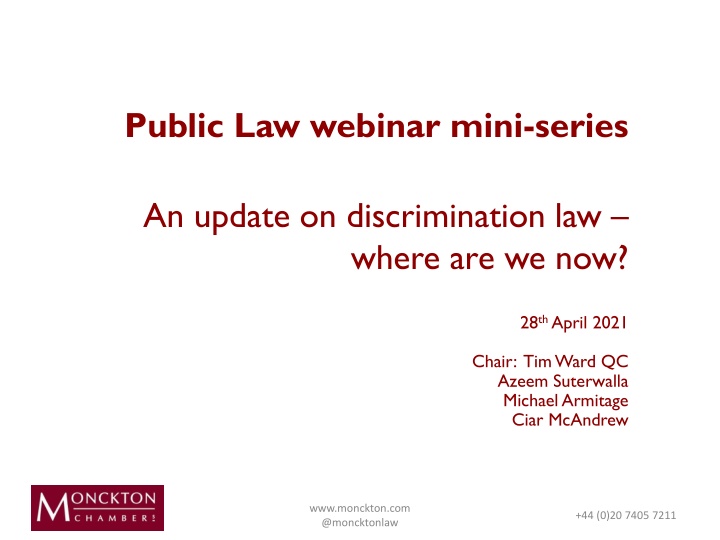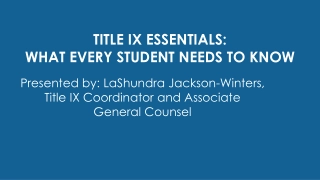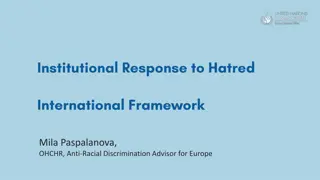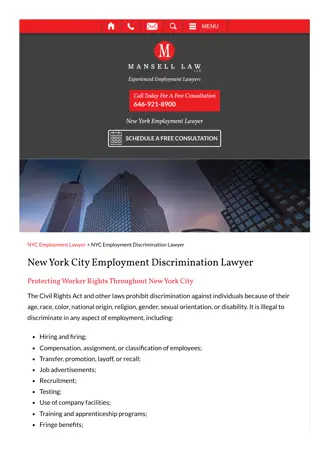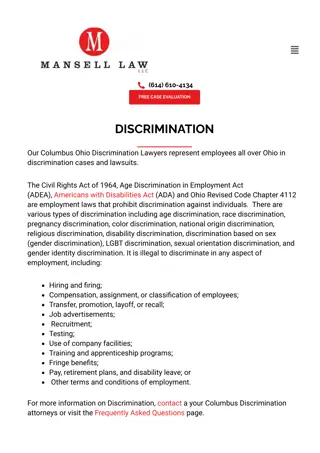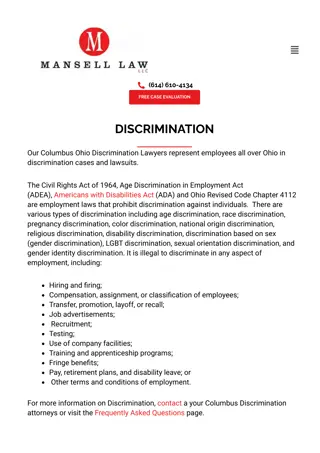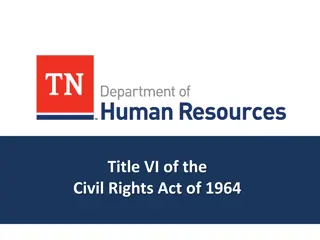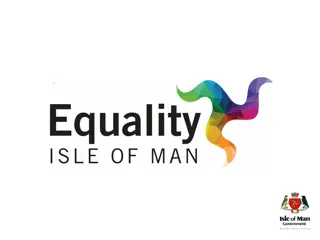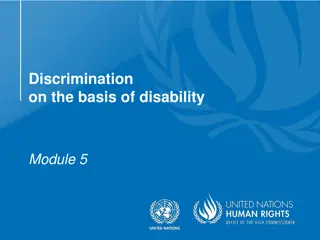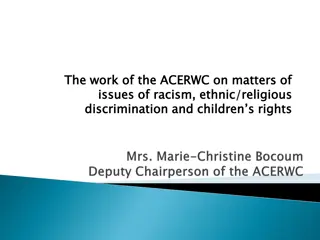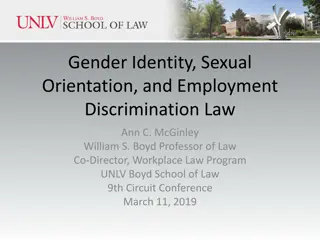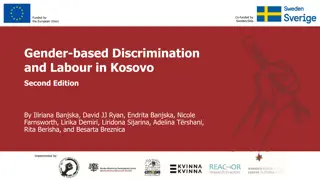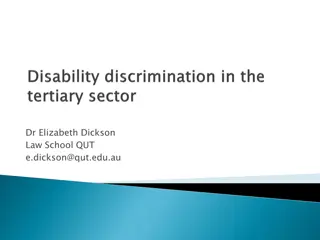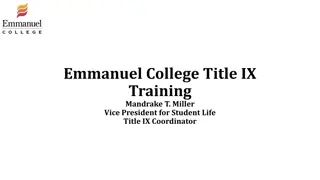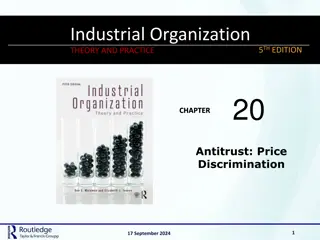Update on Discrimination Law: Where Are We Now? An Insightful Discussion
Delve into the current landscape of discrimination law with expert insights from the Public Law webinar mini-series. Explore topics such as the test for breach under Article 1.4, justification criteria, and the duality of approach in reviewing cases. Understand the standards set by recent court decisions and the critical factors influencing legal determinations in discrimination cases.
Download Presentation

Please find below an Image/Link to download the presentation.
The content on the website is provided AS IS for your information and personal use only. It may not be sold, licensed, or shared on other websites without obtaining consent from the author.If you encounter any issues during the download, it is possible that the publisher has removed the file from their server.
You are allowed to download the files provided on this website for personal or commercial use, subject to the condition that they are used lawfully. All files are the property of their respective owners.
The content on the website is provided AS IS for your information and personal use only. It may not be sold, licensed, or shared on other websites without obtaining consent from the author.
E N D
Presentation Transcript
Public Law webinar mini-series An update on discrimination law where are we now? 28thApril 2021 Chair: Tim Ward QC Azeem Suterwalla Michael Armitage Ciar McAndrew www.monckton.com @moncktonlaw +44 (0)20 7405 7211
Article 1 4 and the test for justification. Where are we now? Azeem Suterwalla Barrister Monckton Chambers www.monckton.com @moncktonlaw +44 (0)20 7405 7211
Recap on test for breach under A14 (1) Does the alleged discrimination fall within the ambit of a Convention right? (2) Is the alleged ground of discrimination a status listed/falling within A14? (3) Has the claimant been treated less favourably than a class of persons whose situation is relevantly similar? (4) Is there an objective and reasonable justification for the difference in treatment? www.monckton.com @moncktonlaw +44 (0)20 7405 7211
Test for Justification (1) Does the measure have a legitimate aim sufficient to justify the limitation of a fundamental right? (2) Is the measure rationally connected to that aim? (3) Could a less intrusive measure have been used? (4) Has a fair balance been struck between the rights of the individual and the interests of the community? www.monckton.com @moncktonlaw +44 (0)20 7405 7211
Standard of review: duality of approach - R (DA) v SSWP [2019] UKSC 21 Second Benefit Cap Case. - Lord Wilson This court has been proceeding down two different paths [55] - On the one hand, case such as Humphreys v Revenue and Customs [2012] UKSC 18 and R (MA) v SSWP [2016] UKSC 68 - On the other hand, Bank Mellat No.2 [2013] UKSC 39 and R (Quila) v SSHD [2011] UKSC 45 www.monckton.com @moncktonlaw +44 (0)20 7405 7211
Duality of Approach (2) See earlier decisions of ECtHR: - James v UK (1986) 8 EHRR 123 - Stec v UK (43 EHRR 1017) Then See decision of SC in In re Recovery of Medical Costs for Asbestos Diseases (Wales) Bill [2015] UKSC 3. www.monckton.com @moncktonlaw +44 (0)20 7405 7211
Which is the correct approach? Lord Kerr and Lady Hale in DA v SSWP [2019] UKSC 21 : - MWRF test is the product of ECtHR used in a different context. - It had been wrongly imported by the domestic courts. - Lord Mance JSC was right in the Asbestos case. BUT All the other Judges of the SC in DA v SSWP disagreed with Lord Kerr and Lady Hale. www.monckton.com @moncktonlaw +44 (0)20 7405 7211
Is that the end of the matter? In DA v SSWP, Lord Wilson JSC at [65] on the correctness of the MWRF test - Let there be no future doubt about it See, however, JD and A v United Kingdom, 24/02/20 R (SC and CB) v SSWP [2019] EWCA Civ 615, decision pending in the SC DA v SSWP now in ECtHR www.monckton.com @moncktonlaw +44 (0)20 7405 7211
Azeem Suterwalla Monckton Chambers asuterwalla@monckton.com
Discrimination in algorithmic decision-making Ciar McAndrew Barrister Monckton Chambers www.monckton.com @moncktonlaw +44 (0)20 7405 7211
JCWI v Home Office Streaming Tool used to categorise visa applicants by reference to nationality - RAG Suspect nationalities given higher risk scores so more scrutiny, a longer wait, and higher refusal rate Direct race discrimination (cf. R (European Roma Rights Centre) v Immigration Officer, Prague Airport [2004] UKHL 55 at 38, 72 and 97) www.monckton.com @moncktonlaw +44 (0)20 7405 7211
Ofqual Exam Algorithm Students grades set by reference to the historical attainment of their school Exemption applied for smaller cohorts where pupils were entitled to receive teacher-assessed grades Indirect discrimination? On what grounds? Appeals process also potentially discriminatory www.monckton.com @moncktonlaw +44 (0)20 7405 7211
(1) Disclosure R (On the application of Eisai Limited) v National Institute for Health and Clinical Excellence [2008] EWCA Civ 438 (at 36, 49-50, 66). Lord Sales, Algorithms, Artificial Intelligence and the Law, 12 November 2019 (p12): There should also be scope for legal challenges to be brought regarding the adoption of algorithmic programs, including at the ex ante stage The claimant will need to secure disclosure of the coding in issue. www.monckton.com +44 (0)20 7405 7211
(2) Procedure Section 149 of the Equality Act 2010: Public authorities must have due regard to the need to eliminate discrimination, foster good relations and advance equality of opportunity. EIA usually required (Lord Sales lecture, p.11). Articles 35/36 GDPR DPIA required where processing, in particular using new technologies , is likely to result in a high risk to the rights and freedoms of natural persons . www.monckton.com +44 (0)20 7405 7211
(3) Expert Input Essential? Useful? www.monckton.com +44 (0)20 7405 7211
Ciar McAndrew Monckton Chambers
Discrimination in algorithmic decision-making Ciar McAndrew Barrister Monckton Chambers www.monckton.com @moncktonlaw +44 (0)20 7405 7211
JCWI v Home Office Streaming Tool used to categorise visa applicants by reference to nationality - RAG Suspect nationalities given higher risk scores so more scrutiny, a longer wait, and higher refusal rate Direct race discrimination (cf. R (European Roma Rights Centre) v Immigration Officer, Prague Airport [2004] UKHL 55 at 38, 72 and 97) www.monckton.com @moncktonlaw +44 (0)20 7405 7211
Ofqual Exam Algorithm Students grades set by reference to the historical attainment of their school Exemption applied for smaller cohorts where pupils were entitled to receive teacher-assessed grades Indirect discrimination? On what grounds? Appeals process also potentially discriminatory www.monckton.com @moncktonlaw +44 (0)20 7405 7211
(1) Disclosure R (On the application of Eisai Limited) v National Institute for Health and Clinical Excellence [2008] EWCA Civ 438 (at 36, 49-50, 66). Lord Sales, Algorithms, Artificial Intelligence and the Law, 12 November 2019 (p12): There should also be scope for legal challenges to be brought regarding the adoption of algorithmic programs, including at the ex ante stage The claimant will need to secure disclosure of the coding in issue. www.monckton.com +44 (0)20 7405 7211
(2) Procedure Section 149 of the Equality Act 2010: Public authorities must have due regard to the need to eliminate discrimination, foster good relations and advance equality of opportunity. EIA usually required (Lord Sales lecture, p.11). Articles 35/36 GDPR DPIA required where processing, in particular using new technologies , is likely to result in a high risk to the rights and freedoms of natural persons . www.monckton.com +44 (0)20 7405 7211
(3) Expert Input Essential? Useful? www.monckton.com +44 (0)20 7405 7211
Ciar McAndrew Monckton Chambers
Positive action in the Supreme Court The decision in R (Z) v LB Hackney & AIHA Michael Armitage Barrister Monckton Chambers www.monckton.com @moncktonlaw +44 (0)20 7405 7211
no one wants to feel they have got the job in any way other than on their own merits Baroness Hale, Guardian, 1 January 2019 www.monckton.com @moncktonlaw +44 (0)20 7405 7211
Section 158, Equality Act 2010 (1) This section applies if a person (P) reasonably thinks that (a) persons who share a protected characteristic suffer a disadvantage connected to the characteristic, (b) persons who share a protected characteristic have needs that are different from the needs of persons who do not share it, or (c) participation in an activity by persons who share a protected characteristic is disproportionately low. (2) This Act does not prohibit P from taking any action which is a proportionate means of achieving the aim of (a) enabling or encouraging persons who share the protected characteristic to overcome or minimise that disadvantage, (b) meeting those needs, or (c) enabling or encouraging persons who share the protected characteristic to participate in that activity. www.monckton.com @moncktonlaw +44 (0)20 7405 7211
Section 158 and positive discrimination we would stress that section 158 does not concern what is sometimes called "positive discrimination"; it is more limited and concerns only what the legislation calls "positive action". In general "positive discrimination" is unlawful under the Equality Act ... R (Adath Yisroel Burial Society) v HM Senior Coroner for Inner North London [2018] EWHC 969 Admin; [2019] QB 251 Divisional Court (Singh LJ and Whipple J) www.monckton.com @moncktonlaw +44 (0)20 7405 7211
AIHAs policy CONSIDERATION ONLY TO THE ORTHODOX JEWISH COMMUNITY www.monckton.com @moncktonlaw +44 (0)20 7405 7211
Case C-319/03 Briheche A measure which is intended to give priority in promotion to women in sectors of the public service must be regarded as compatible with Community law if it does not automatically and unconditionally give priority to women when women and men are equally qualified, and the candidatures are the subject of an objective assessment which takes account of the specific personal situations of all candidates (para 23) www.monckton.com @moncktonlaw +44 (0)20 7405 7211
Proportionality on appeal (1) Since the Divisional Court gave itself a correct self-direction as to the test to be applied, its conclusion that AIHA s allocation policy is a proportionate means of pursuing the legitimate aims identified can only be set aside if the appeal court comes to the view that its conclusion was wrong in the relevant sense. It is not sufficient that an appellate court might think it would have arrived at a different conclusion had it been considering the matter for the first time (Lord Sales JSC at [74]) www.monckton.com @moncktonlaw +44 (0)20 7405 7211
Proportionality on appeal (2) if the appellate court only conceives of its role as checking that the first instance court has directed itself in an appropriate way and then reached a result which cannot be said to be unreasonable [s]ociety does not benefit from application of the wisdom of senior judges on some of the most difficult and sensitive cases which come before the courts. Proportionality review in appellate courts: a wrong turning? Lord Sales Annual ALBA Lecture, November 2020 www.monckton.com @moncktonlaw +44 (0)20 7405 7211
Michael Armitage Monckton Chambers marmitage@monckton.com
